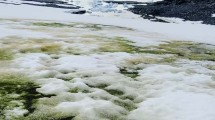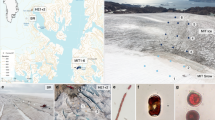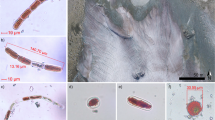Abstract
A lack of liquid water limits life on glaciers worldwide but specialized microbes still colonize these environments. These microbes reduce surface albedo, which, in turn, could lead to warming and enhanced glacier melt. Here we present results from a replicated, controlled field experiment to quantify the impact of microbes on snowmelt in red-snow communities. Addition of nitrogen–phosphorous–potassium fertilizer increased alga cell counts nearly fourfold, to levels similar to nitrogen–phosphorus-enriched lakes; water alone increased counts by half. The manipulated alga abundance explained a third of the observed variability in snowmelt. Using a normalized-difference spectral index we estimated alga abundance from satellite imagery and calculated microbial contribution to snowmelt on an icefield of 1,900 km2. The red-snow area extended over about 700 km2, and in this area we determined that microbial communities were responsible for 17% of the total snowmelt there. Our results support hypotheses that snow-dwelling microbes increase glacier melt directly in a bio-geophysical feedback by lowering albedo and indirectly by exposing low-albedo glacier ice. Radiative forcing due to perennial populations of microbes may match that of non-living particulates at high latitudes. Their contribution to climate warming is likely to grow with increased melt and nutrient input.
This is a preview of subscription content, access via your institution
Access options
Access Nature and 54 other Nature Portfolio journals
Get Nature+, our best-value online-access subscription
$29.99 / 30 days
cancel any time
Subscribe to this journal
Receive 12 print issues and online access
$259.00 per year
only $21.58 per issue
Buy this article
- Purchase on Springer Link
- Instant access to full article PDF
Prices may be subject to local taxes which are calculated during checkout




Similar content being viewed by others
References
Wiscombe, W. J. & Warren, S. G. A model for the spectral albedo of snow. I: Pure snow. J. Atmos. Sci. 37, 2712–2733 (1980).
Box, J. et al. Greenland ice sheet albedo feedback: thermodynamics and atmospheric drivers. Crysophere 6, 821–839 (2012).
Flanner, M. G., Zender, C. S., Randerson, J. T. & Rasch, P. J. Present-day climate forcing and response from black carbon in snow. J. Geophys. Res. 112, D11202 (2007).
Bryant, A. C., Painter, T. H., Deems, J. S. & Bender, S. M. Impact of dust radiative forcing in snow on accuracy of operational runoff prediction in the Upper Colorado River Basin. Geophys. Res. Lett. 40, 3945–3949 (2013).
Hood, E. et al. Glaciers as a source of ancient and labile organic matter to the marine environment. Nature 462, 1044–1047 (2009).
Musilova, M. et al. Microbially driven export of labile organic carbon from the Greenland ice sheet. Nat. Geosci. 10, 360–365 (2017).
Kohshima, S., Seko, K. & Yoshimura, Y. In Snow and Glacier Hydrology 309–316 (Publication no. 218, IAHS, 1993).
Thomas, W. H., Duval, B. & Nevada, S. California, USA, snow algae: snow albedo changes, algal-bacterial interrelationships, and ultraviolet radiation effects. Arct. Alp. Res. 27, 389–399 (1995).
Painter, T. H. et al. Detection and quantification of snow algae with an airborne imaging spectrometer. Appl. Environ. Microbiol. 67, 5267–5272 (2001).
Takeuchi, N., Dial, R. D., Kohshima, S., Segawa, T. & Uetake, J. Spatial distribution and abundance of red snow algae on the Harding Icefield, Alaska derived from a satellite image. Geophys. Res. Lett. 33, L21502 (2006).
Yallop, M. L. et al. Photophysiology and albedo-changing potential of the ice algal community on the surface of the Greenland ice sheet. ISME J. 6, 2302–2313 (2012).
Takeuchi, N., Kohshima, S. & Seko, K. Structure, formation, and darkening process of albedo-reducing material (cryoconite) on a Himalayan glacier: a granular algal mat growing on the glacier. Arct. Antarct. Alp. Res. 33, 115–122 (2001).
Stibal, M., Šabacká, M. & Žárský, J. Biological processes on glacier and ice sheet surfaces. Nat. Geosci. 5, 771–774 (2012).
Lutz, S., Anesio, A. M., Villar, S. E. & Benning, L. G. Variations of algal communities cause darkening of a Greenland glacier. FEMS Microbiol. Ecol. 89, 402–414 (2014).
Takeuchi, N. et al. The effect of impurities on the surface melt of a glacier in the Suntar-Khayata mountain range, Russian Siberia. Front. Earth Sci. 3, 82–92 (2015).
Lutz, S. et al. The biogeography of red snow microbiomes and their role in melting arctic glaciers. Nat. Commun. 7, 11968 (2016).
Musilova, M., Tranter, M., Bamber, J. L., Takeuchi, N. & Anesio, A. M. Experimental evidence that microbial activity lowers the albedo of glaciers. Geochem. Perspect. Lett. 2, 106–116 (2016).
Cook, J. M., Hodson, A. J., Taggart, A. J., Mernild, S. H. & Tranter, M. A predictive model for the spectral “bioalbedo” of snow. J. Geophys. Res. 122, 434–454 (2017).
Lutz, S., Anesio, A. M., Edwards, A. & Benning, L. G. Linking microbial diversity and functionality of arctic glacial surface habitats. Environ Microbiol. 19, 551–565 (2016).
Hoham, R. W. & Duval, B. Snow Ecology: An Interdisciplinary Examination of Snow-Covered Ecosystems 168–228 (Cambridge Univ. Press, 2001).
Anesio, A. M. & Laybourn-Parry, J. Glaciers and ice sheets as a biome. Trends Ecol. Evol. 27, 219–225 (2011).
Hodson, A. et al. Glacial ecosystems. Ecol. Monogr. 78, 41–67 (2008).
Bidigare, R. et al. Evidence for a photoprotective for secondary carotenoids of snow algae. J. Phycol. 29, 427–434 (1993).
Remias, D., Lütz-Meindl, U. & Lütz, C. Photosynthesis, pigments and ultrastructure of the alpine snow alga Chlamydomonas nivalis. Eur. J. Phycol. 40, 259–268 (2005).
VanLooy, J., Foster, R. & Ford, A. Accelerating thinning of Kenai Peninsula glaciers, Alaska. J. Glaciol. 44, 570–582 (1998).
Fujii, M. et al. Microbial community structure, pigment composition, and nitrogen source of red snow in Antarctica. Microbial Ecol. 59, 466–475 (2010).
Hamilton, T. L. & Havig, J. Primary productivity of snow algae communities on stratovolcanoes of the Pacific Northwest. Geobiology 15, 280–295 (2017).
Elser, J. J. et al. Global analysis of nitrogen and phosphorus limitation of primary producers in freshwater, marine and terrestrial ecosystems. Ecol. Lett. 10, 1135–1142 (2007).
Takeuchi, N. The altitudinal distribution of snow algae on an Alaska glacier (Gulkana Glacier in the Alaska Range). Hydrol. Process. 15, 3447–3459 (2001).
Hock, R. Temperature index melt modelling in mountain areas. J. Hydrol. 282, 104–111 (2003).
Di Mauro, B. et al. Mineral dust impact on snow radiative properties in the European Alps combining ground, UAV, and satellite observations. J. Geophys. Res. 120, 6080–6097 (2015).
Peltoniemi, J. I. et al. Soot on Snow experiment: bidirectional reflectance factor measurements of contaminated snow. Cryosphere 9, 2323–2337 (2015).
Conway, H., Gades, A. & Raymond, C. F. Albedo of dirty snow during conditions of melt. Wat. Resour. Res. 32, 1713–1718 (1996).
Doherty, S. J., Warren, S. G., Grenfell, T. C., Clarke, A. D. & Brandt, R. E. Light-absorbing impurities in Arctic snow. Atmos. Chem. Phys. 10, 11647–11680 (2010).
Sturm, M. et al. 2001: Snow–shrub interactions in Arctic tundra: a hypothesis with climatic implications. J. Clim. 14, 336–344 (2001).
IPCC Climate Change 2014: Synthesis Report (eds Core Writing Team, Pachauri, R. K. & Meyer, L. A.) (Cambridge Univ. Press, 2014).
Keegan, K. M., Albert, M. R., McConnell, J. R. & Baker, I. Climate change and forest fires synergistically drive widespread melt events of the Greenland ice sheet. Proc. Natl Acad. Sci. USA 111, 7964–7967 (2014).
Quinton, J. N., Govers, G., Van Oost, K. & Bardgett, R. D. The impact of agricultural soil erosion on biogeochemical cycling. Nat. Geosci. 3, 311–314 (2010).
Harper, J., Humphrey, N., Pfeffer, W. T., Brown, J. & Fettweis, X. Greenland ice-sheet contribution to sea-level rise buffered by meltwater storage in firn. Nature 491, 240–243 (2012).
Hubbard, B. & Glasser, N. F. Field Techniques in Glaciology and Glacial Geomorphology (John Wiley, 2005).
Dial, R. J. et al. The role of temperature in the distribution of the glacier ice worm Mesenchytraeus solifugus (Annelida: Oligochaeta: Enchytraeidae). Arct. Antarct. Alp. Res. 48, 199–211 (2016).
Sass, L. C., Loso, M. G., Geck, J., Thoms, E. E. & McGrath, D. Geometry, mass balance and thinning at Eklutna Glacier, Alaska: an altitude-mass-balance feedback with implications for water resources. J. Glaciol. 63, 343–354 (2017).
Ricchiazzi, P., Yang, S. R., Gautier, C. & Sowle, D. SBDART: a research and teaching software tool for plane-parallel radiative transfer in the Earth’s atmosphere. Bull. Am. Meteorol. Soc. 79, 2101–2114 (1998).
Collins, A. M. et al. Carotenoid distribution in living cells of Haematococcus pluvialis (Chlorophyceae). PLoS ONE 6, e24302 (2011).
Acknowledgements
C. McNeil, T. Tumulo, A. Meyerhofer, K. Loan, J. Geck, T. Golden and C. Tobin assisted, and D. Kurtz and the National Park Service permitted the research. NASA Alaska Space Grant funded G.Q.G. and R.J.D.; National Institute for Water Resources funded R.J.D. and M.G.L.; Anchorage Municipal Light and Power and Anchorage Water and Wastewater Utility funded M.G.L.
Author information
Authors and Affiliations
Contributions
R.J.D. conceived and coordinated the project. G.Q.G. and R.J.D. designed ecology studies. G.Q.G. and M.G.L. performed glaciology. A.B.B., G.Q.G. and R.J.D. performed spectrometry. G.Q.G. and R.J.D. performed remote sensing. G.Q.G., M.G.L., and R.J.D. performed fieldwork. G.Q.G. performed laboratory counts. G.Q.G. and R.J.D. performed statistical modelling. R.J.D. wrote the paper with input from all.
Corresponding author
Ethics declarations
Competing interests
The authors declare no competing financial interests.
Supplementary information
Supplementary Information
Supplementary Information (PDF 1311 kb)
Supplementary Information
Supplementary Information (MP4 36439 kb)
Rights and permissions
About this article
Cite this article
Ganey, G., Loso, M., Burgess, A. et al. The role of microbes in snowmelt and radiative forcing on an Alaskan icefield. Nature Geosci 10, 754–759 (2017). https://doi.org/10.1038/ngeo3027
Received:
Accepted:
Published:
Issue Date:
DOI: https://doi.org/10.1038/ngeo3027
This article is cited by
-
Antarctic snow algae: unraveling the processes underlying microbial community assembly during blooms formation
Microbiome (2023)
-
A cleaner snow future mitigates Northern Hemisphere snowpack loss from warming
Nature Communications (2023)
-
Albedo change from snow algae blooms can contribute substantially to snow melt in the North Cascades, USA
Communications Earth & Environment (2023)
-
Snow Microorganisms Colonise Arctic Soils Following Snow Melt
Microbial Ecology (2023)
-
Biological and Pollution Aerosols on Snow and Ice—Interplay between the Atmosphere and the Cryosphere
Journal of Earth Science (2023)



